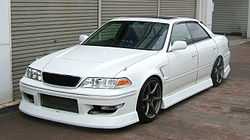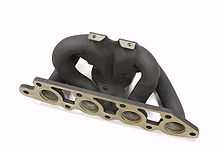Performance car

.jpg)

A performance car is an automobile that is designed and constructed specifically for speed. The design and construction of a performance car involves not only providing a capable power train but also providing the handling and braking systems to support it.
Performance cars are road vehicles, capable of providing transport. Specially designed racing cars are not normally regarded as performance cars, but performance cars are often raced.
There is a great deal of overlap between performance cars and sports cars, but not all performance cars are sports cars, and not all sports cars are performance cars. The MG TC, for example, is a prototypical sports car, but even by the standards of its day was unexceptional in its performance.
Similarly, some hot rods are performance cars, but many hot rods are either built for show rather than for performance, or are not intended to be roadworthy, or both. Those hot rods that are built for on-road performance tend to emphasise straight line speed and acceleration, and in this they represent one extreme of a continuum of performance cars, the opposite extreme of which is represented by cars that emphasise handling rather than straight line speed, such as the Lotus Elise.
Performance cars include:
- Coupés
- Grand tourers
- Hot Hatches
- Muscle cars
- Sport compacts
- Sports sedans
- Supercars
These classifications overlap.
Performance cars can also be classified according to their source:
- Some luxury car marques, such as Ferrari, Maserati, Aston Martin, Bolwell and Porsche, produce only performance cars. These are designed from the outset for performance.
- Some car makers have subsidiaries dedicated to developing high-performance versions of their cars, such as Holden Special Vehicles, quattro GmbH, BMW-Alpina and Mercedes-AMG.
- Some performance cars are unique or low-volume specials based on production vehicles fitted with aftermarket and/or custom-built parts independently of the manufacturer.
Corporate takeovers and the increasing interdependance of car makers for major components such as engines and even vehicle platforms has blurred the distinction between the first two types. Fiat, for example, currently owns a controlling interest in Ferrari and at one time owned Maserati outright.

The third category includes many vehicles built by the owners as a hobby. A large segment of the automotive aftermarket industry is dedicated to such performance-enhancing modifications.
See also
External links
- http://www.hotrod.org.nz/Merchandise%20Page%20Files/HCTM%20Background.pdf New Zealand handbook for road-legal performance cars